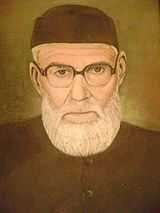Hakim Syed Fazlur Rahman
|
Hakim Syed Fazlur Rahman | |
| Born |
December 18, 1912 Tijara |
|---|---|
| Residence | Bhopal / Aligarh |
| Known for | Unani medicine |
Hakim Syed Fazlur Rahman (1912–1994) was a noted Unani physician from Tijara and Bhopal.
Brief biography
Syed Fazlur Rahman (8th Muharram 1331AH/18 December 1912 – 27th Rajab 1414AH/10 January 1994) belonged to the family of Gardēzī Sadaat. Being ‘Hakim’ by profession, he also had deep interest in mysticism (Tasawwuf) and Sufism. He followed Sufi path as he had great faith (‘Aqidah’) over the ‘Huwalshaafi’, which is in effect a physician of the heart, able to diagnose the seeker's hindrance to knowledge and pure intention in serving the God, and to prescribe to the seeker a course of treatment appropriate to his or her maladies. Through both devotional practices of Sufism and Unani, he treated many patients by serving Ta'wiz and drugs.
He was closely associated with the shrine of Sufi saint Khwaja Khanoon (Shah-e-Willayat) and Muhammad Ghawth Gwaliyari. He used to attend Urs of Hazrat Khwaja Khanoon Sahib every year at his Dargah. He also published a book (Jalwa-e Khanoon), which is basically a compilation of Poems composed in praise of Shah-e-Willayat Hazrat Khwaja Khanoon Sahib, published from Roohani Academy, Gwalior in 1965.
Apart from 'Jalwa-e Khanoon', he authored 'Usool-e Sehat' and 'Yaad-e Nazir' in addition to memoirs of Iraq's visit.
Pilgrimage tour and Hajj
In 1954, Hakim Syed Fazlur Rahman along with Sajjada Nashin Khwaja Hameeduddin Shah Khanooni, the grandfather of the present Sajjada Nashin Khwaja Rashid Khanooni, went for Ziyarat to many cities of Iraq like Karbala, Basra, Samarra, Najaf to visit the tomb of Imām Ali, Kufa to visit Masjid al-Kufa, Kazmain to visit Al-Kadhimiya Mosque, Baghdad to visit the shrine and mosque of Ghaus al Azam Shaikh Abdul Qadir Gilani and the mosque of Abū Ḥanīfa.[1]
He performed Hajj in 1982 via sea route from Bombay port.
Family and life

Born in Tijara, Hakim Syed Fazlur Rahman started family profession (Unani way of treatment) from the very early life with his father Hakim Syed Karam Husain (1870–1953) and elder brother Hafiz Hakim Syed Atiqul Qadir (1900–2000) at Dawakhana Shifaul Amraz.[2]
After partition of India and complete devastation of the whole region of Alwar and Tijara, the family of Hakim Syed Fazlur Rahman migrated to Bhopal and started afresh the whole set up of the 'Dawakhana'. Many of his family members were already living in Bhopal before the partition of India since 1857, even his wife, Haneefa Begum, daughter of Qazi Khaliluddin, whom he married on 17 Jumada al-awwal 1349 AH / 9 November 1930 belonged to Bhopal.
She died at the age of 32 years on 14th Shawwal 1365 AH / 11 December 1946. Hakim Syed Fazlur Rahman practiced Tibb in Bhopal first with his father and then with his elder brother till 1975. Later on because of his ill health especially after the fracture of neck of femur and had the only son in Aligarh, he again migrated to Aligarh in the late 1975. In Aligarh, he continued practicing until death. He is buried in the graveyard of Aligarh Muslim University (Minto E).[3]
He left behind two daughters and one son Hakim Syed Zillur Rahman. Eldest daughter Tayyaba Begum is married to Mohammad Nooruddin Nadvi (son of Maulvi Haji Halimuddin ibn Qazi Khaliluddin) while youngest daughter Tajjalia Begum (died 2010) was married to Ghyasuddin (son of Shaikh Qamaruddin of Betul).
See also
- Hakim Fazlur Rahman Museum on Arts, Culture and Orientalism
- Tijara
- Syed Mohammad Ashraf (great grandfather)
- Qazi Mir Imdad Ali (grandfather)
- Hakim Syed Zillur Rahman (son)
- Syed Ziaur Rahman (grandson)
References
- ↑ Hakim Syed Zillur Rahman (1983, revised second edition 2008), "Pasmandgan", Ḥayāt-i Karam Ḥusain, ʻAlīgaṛh: Ibn Sina Academy of Medieval Medicine and Sciences, pp. 266–276 Check date values in:
|date=(help) - ↑ Keswani, Nandkumar H (1970). "Medical Education in India since ancient times". In Victor E. Hall and CD O’Malley. UCLA Forum in Medical Sciences (No. 12) – The history of Medical Education (12th ed.). California, LA: University of California Press. pp. 329–366. ISBN 0-520-01578-9.
- ↑ Hakim Syed Fazlur Rahman, ‘Tamir’, Haryana Urdu Academy, Chandigarh, January 1996, p. 27-32.
